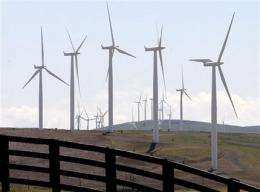Northwest power surplus may halt wind energy

(AP) -- The manager of most of the electricity in the Pacific Northwest is running such a surplus of power from hydroelectric dams that it put wind farms on notice Friday that they may be shut down as early as this weekend.
The Bonneville Power Administration has more than enough electricity during a cold, wet spring that has created a big surge in river flows where hydroelectric dams are located. The agency responded by announcing its intentions to curtail wind power until the grid has more capacity, in a move likely to cost the industry millions of dollars.
The decision reflects an overlooked issue amid the push to add wind farms around the country: The capacity of power grids has not kept pace.
How soon and low long wind farms might be shut down depends on how quickly the region warms up and the water shoots downriver to the Pacific Ocean, said Steven Wright, administrator of the BPA. The farms that would be shut down are mostly in Washington and Oregon.
The main culprit for the wind slowdown is spring weather that followed a winter with heavy snow in the mountains feeding the Columbia River basin. The spring surge is expected to be the largest since 1997.
When water levels are this high, the agency said, it has no choice but to use the water to generate electricity in hydroelectric dams. Laws protecting endangered species prevent it from sending all the excess water through spillways and around the dams. That beats up salmon and steelhead. It also creates so much nitrogen gas bubbling in the water that the fish get the equivalent of the bends.
Grid operators say they have run out of capability to sell the surplus electricity, store the water or shut down gas, oil, and nuclear plants - leaving wind farms the unfortunate victim.
The financing of many wind farms relies on tax credits that are of benefit only if electricity is produced. And the decision could set the stage for even more significant fights in the years to come if the Northwest wind industry doubles its capacity, as projected, over the next decade.
Major wind interests, including mainstream utilities such as Portland General Electric, have opposed the BPA's proposal and are suggesting lawsuits are next. The utility says the move could violate antitrust and market manipulation laws.
The critics also noted that President Barack Obama and Energy Secretary Steven Chu, who reappointed Wright just last year, have been staunch advocates of alternative energy such as wind power.
Salmon advocates also lined up with the wind industry out of solidarity between two groups with a long history of common environmental interests.
"It is strange how a federal agency could make this kind of decision," said Nicole Cordan of Save Our Wild Salmon. She and other critics said the BPA hadn't explored enough options. The BPA said those options would cost its traditional customers, such as public power districts, extra.
No good estimates were immediately available of what wind developers stand to lose. BPA projections earlier this year showed that curtailing wind power over a three-month period, in a worst-case scenario, could cost them as much as $50 million.
The action reflects difficulty in integrating the young wind industry into a power grid that dates to the Northwest dam-building campaign that began in the Depression and kicked into high gear after World War II.
In the past decade, state and federal governments have encouraged wind farms by requiring utility companies to obtain larger amounts of power from renewable sources and by granting tax credits. But power grid capacity hasn't enjoyed a similar expansion.
Wright said wind farms developed faster than he expected, given the severity of the recession, and regional interests have failed to find ways around the problem, leading him to realize only a few months ago that such a shutdown was likely.
"We're talking about a surplus of low-cost, carbon-free energy, and it just seemed to me there would be a solution," he said.
As it happens, the impact of the shutdown would hit hardest along the river, which cuts a famous gorge and forms something of a wind tunnel ideal for the hundreds of white turbine towers standing like pickets on the bluffs above. The capacity of the generators varies, but some are rated at up to 2 megawatts - the BPA estimates 1 megawatt can power about 700 typical homes.
Among the states, Oregon and Washington rank Nos. 4 and 5, respectively, in the amount of wind power capacity deployed, according to the most recent rankings of the American Wind Energy Association.
The Bonneville Power Administration handles about three-quarters of the Northwest's transmission and has long dealt with high water in the spring.
Coal- and gas-fired energy plants often schedule downtime for maintenance in the spring to allow electricity generators at dams to produce more. That was the rationale for the current shutdown of the Northwest's only commercial nuclear plant, at the Hanford nuclear reservation, for refueling and maintenance.
Last year, a spring storm sent a surge of wind power into the Northwest grid, and operators feverishly made adjustments.
The Bonneville Power Administration is a self-financed federal enterprise that manages three-quarters of the electrical transmission in the Northwest and sells power from 31 dams and the nuclear plant, accounting for about a third of the supply in the Northwest. Its area includes parts of eight western states.
©2011 The Associated Press. All rights reserved. This material may not be published, broadcast, rewritten or redistributed.

















